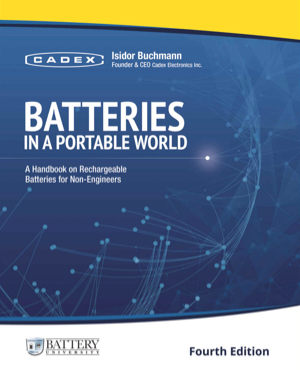With the move from analog to digital devices, new demands are being placed on the battery. Unlike analog equipment that draws a predictable and steady current, digital devices load the battery with short, high current bursts.
One of the urgent requirements of a battery for digital applications is low internal resistance. Measured in milliohms (mΩ), the internal resistance is the gatekeeper that, to a large extent, determines the runtime. The lower the resistance, the less restriction the battery encounters in delivering the needed power bursts. A high mΩ reading can trigger an early ‘low battery’ indication on a seemingly good battery because the available energy cannot be fully delivered.
In this article we examine the current requirements of analog and digital communications devices. Figure 1 provides typical examples of peak current of the analog two-way and digital Tetra radio, as well as the AMP, GSM, TDMA and CDMA mobile phones.
| AMP | GSM | TDMA1 | CDMA | ||
| Type | Analog | Digital | Digital | Digital | |
| Used in | USA, Canada | Globally | USA, Canada | USA, Canada | |
| Peak Power | 0.6W | 1-2W | 0.6-1W | 0.2W | |
| Peak current2 | 0.3A DC | 1-2.5A | 0.8-1.5A | 0.7A | |
| In service since | 1985 | 1986 | 1992 | 1995 | |
Figure 1: Peak power requirements of popular global mobile phone systems.
Moving from analog to digital equipment reduces the overall energy need but increases the peak current during load pulses. The wattage varies with signal strength.
Why do seemingly good batteries fail on digital equipment?
Service technicians have been puzzled by the seemingly unpredictable battery behavior when powering digital equipment. With the switch from analog to digital wireless communications devices, particularly mobile communications equipment, a battery that performs well on an analog system may show irrational behavior when used on a digital unit. Testing these batteries with a battery analyzer produces good capacity readings. Why then do some batteries fail on digital devices but not on analog?
The overall energy requirement of a digital mobile phone is less than that of the analog equivalent, however, the battery must be capable of delivering high current pulses that are often several times that of the battery’s rating. Let’s look at the battery rating as expressed in C‑rates.
A 1C discharge of a battery rated at 500mAh is 500mA. In comparison, a 2C discharge of the same battery is 1000mA. A GSM phone powered by a 500mA battery that draws 1.5A pulses loads the battery with a whopping 3C discharge.
A 3C rate discharge is acceptable for a battery with very low internal resistance. However, aging batteries, especially Li‑ion and NiMH chemistries, pose a challenge because the mΩ readings increase with use. Improved performance can be achieved by using a larger battery, also known as an extended pack. Somewhat bulkier and heavier, an extended pack offers a typical rating of about 1000mAh or roughly double that of the slim-line. In terms of C‑rate, the 3C discharge is reduced to 1.5C when using a 1000mAh instead of a 500mAh battery.
As part of ongoing research to find the best battery system for wireless devices, Cadex has performed life cycle tests on various battery systems. In Figures 2 to 4 we examine NiCd, NiMH and Li‑ion batteries, each of which generate a good capacity reading when tested with a battery analyzer but produce stunning differences on a pulsed discharge of 1C, 2C and 3C. These pulses simulate a GSM phone.
A closer look reveals vast discrepancies in the mΩ measurements of the test batteries. In fact, these readings are typical of batteries that have been in use for a while. The NiCd shows 155mΩ, the NiMH 778mΩ and the Li‑ion 320mΩ, although the capacities checked in at 113, 107 and 94 percent respectively when tested with the DC load of a battery analyzer. It should be noted that the internal resistance of a new battery reads between 75 to 150mΩ.
From these charts we observe that the talk-time is in close relationship with the battery’s internal resistance. The NiCd produces a long talk time at all C-rates. In comparison, the NiMH only works at a lower C-rate. The Li‑ion performs better but is marginally at a 3C discharge.

Figure 2: Talk-time of a NiCd battery under the GSM load schedule.
This battery has 113% capacity and 155mΩ internal resistance.

Figure 3: Talk-time of a NiMH battery under the GSM load schedule.
This battery has 107% capacity and 778mΩ internal resistance.

Figure 4: Talk-time of a Li‑ion battery under the GSM load schedule.
This battery has 94% capacity and 320mΩ internal resistance.

Comments
Looking for comments from the previous website?
Comments from the previous website are not compatible with our new commenting system but we have preserved them so our users can still reference and make use the information in them.
